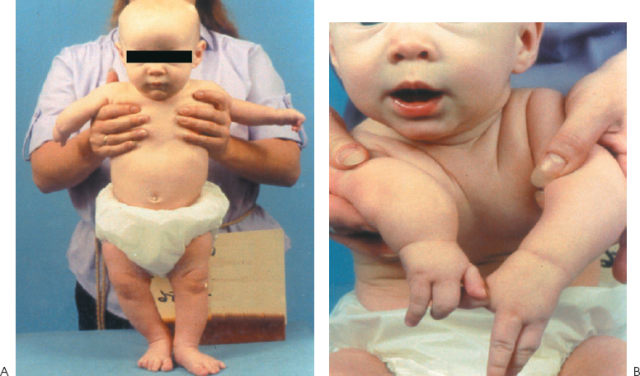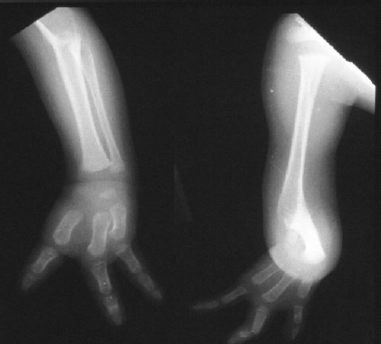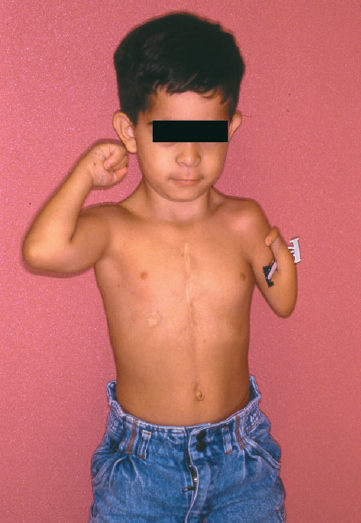77
Ulnar Deficiency (Ulnar Clubhand)
Scott H. Kozin
History and Clinical Presentation
A 5-month-old boy presented with congenital anomalies of both upper extremities (Fig. 77–1). He is the product of a full-term pregnancy, born by cesarean section delivery. There were no complications during pregnancy or delivery. The child is otherwise healthy and has attained his early developmental milestones at the appropriate time. There is no family history of congenital anomalies, including two siblings without abnormalities.
Physical Examination
The patient is a healthy-appearing infant with congenital anomalies of both upper extremities. His right extremity is longer than his left. Both shoulders had full range of motion and strength. Both elbows and forearms had no active or passive motion. The right elbow was fixed at 45 degrees of flexion and the forearm rigid in neutral rotation. The left elbow appeared to be hyperextended with the forearm facing backward and the hand resting on the flank. The left forearm was fixed in 30 degrees of pronation and appeared foreshortened compared with the right.

Figure 77–1 (A) A 5-month-old child with congenital anomalies of both upper extremities. The right elbow is fused in slight flexion and the left elbow is fused facing backward. (B) Hand anomalies with bilateral three-digit hands.
The right wrist had full flexion/extension with apparent absence of the ring and small rays and a three-digit hand (thumb, index, and long) (Fig. 77–1B). These digits appeared normal and possessed full motion with the ability to grasp and release. The left wrist had 30 degrees of extension and 80 degrees of flexion. This hand also possessed three digits with apparent absence of the ring and small rays. The remaining digits were hypoplastic with less movement compared with the right, and there was symphalangism of the most ulnar finger proximal interphalangeal joint. Normal sensation and palpable radial and ulnar pulses were present on both sides.
PEARLS
- Ulnar deficiency is associated with other musculoskeletal abnormalities.
- Ulnar and radial-sided hand anomalies can be present in ulnar deficiency.
- Progressive radial bowing may indicate the presence of an ulnar anlage.
PITFALLS
- Surgery should be approached with caution.
- Surgery should not disturb compensatory maneuvers necessary for function.
- Avoid surgery on pterygium cubitale.
Diagnostic Studies
Radiographs of the upper extremities at age 2½ years indicated anomalies of both sides (Fig. 77–2). The right elbow was fused between the humerus and the radius. The ulna appeared slightly hypoplastic. There was absence of the ring and small rays with normal-appearing thumb, index, and long digits. The left elbow was also fused with the forearm pointing backward. There was absence of the ulna with a small proximal segment remaining. The right wrist demonstrated early ossification of the carpus, whereas the left carpus showed delayed ossification. A three-digit hand was present bilaterally.
Differential Diagnosis
Ulnar deficiency (ulnar clubhand)
Radial deficiency (radial clubhand)
Arthrogryposis multiplex congenita
Proximal radioulnar synostosis
Multiple pterygium syndrome

Figure 77–2 Radiograph of both upper extremities. Right side has a fused elbow, hypoplastic-appearing ulna, and three-digit hand. Left side has fused elbow, small proximal ulna remnant, and three-digit hand.

Stay updated, free articles. Join our Telegram channel

Full access? Get Clinical Tree








